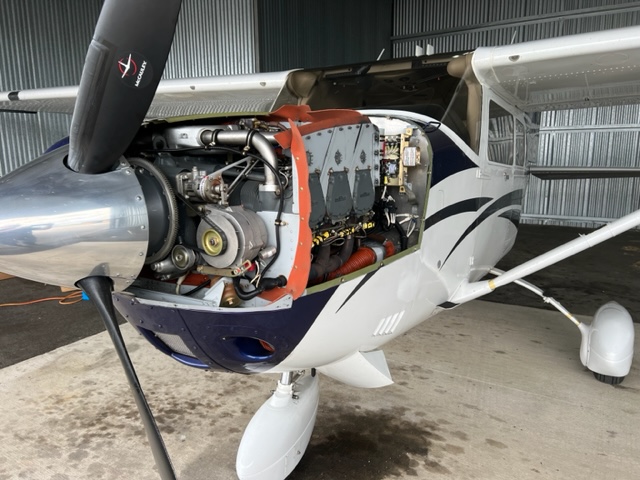Go offline with the Player FM app!
229 – Cessna 206 Alternator Not Working
Manage episode 370821279 series 1028900

The charging system was not working, but why?
There was normal voltage at the alternator field terminal.
The field circuit resistance seemed normal as well.
But the alternator was not producing the normal 28 volts during operation.
Occasionally, it would produce a small amount of output voltage, like 25 or 26 volts, and then drop back down to battery voltage.
Clearly there was a problem.
After troubleshooting and seeking advice from a Cessna service center, we replaced the battery contactor and the alternator contactor in the MCU (master control unit) on the firewall. (The MCU is the electrical control box for the airplane. It’s located on the forward left side of the firewall.)
Replacing the contactors did not fix the problem.
After more troubleshooting and some calls to Hartzell Engine Technologies to speak with two different people, and after talking things over with the owner, we decided to order an overhauled alternator and a new ACU (alternator control unit.)
They arrived the next day, I installed them, and the system worked perfectly.
The alternator was back to producing its normal 28 volts. (I just wish I had taken the old alternator apart to see if I could determine the problem… I’m guessing one or both of the brushes were severely worn.)
The following photo shows what’s inside the MCU. The alternator contactor is the one in the top of the photo, slightly left of center. And the alternator control unit the the device to the left of the contactor that says “Lamar” on the side.
When replacing anything in this box, it’s very helpful to take photos first in order to put everything back in its place during reassembly!

Listen to the audio podcast for this episode to get the full story.
This episode also includes some of the email responses I received after asking if listeners wanted to continue receiving stories about exhaust valves.
Thank you to all who responded!
In a nutshell, everyone wanted to continue hearing about exhaust valves and the stories about lapping them and saving them, especially the stories that are instructive and educational.
Have a great week everyone!
The post, “229 – Cessna 206 Alternator Not Working” appeared first at AirplaneOwnerMaintenance.com
158 episodes
Manage episode 370821279 series 1028900

The charging system was not working, but why?
There was normal voltage at the alternator field terminal.
The field circuit resistance seemed normal as well.
But the alternator was not producing the normal 28 volts during operation.
Occasionally, it would produce a small amount of output voltage, like 25 or 26 volts, and then drop back down to battery voltage.
Clearly there was a problem.
After troubleshooting and seeking advice from a Cessna service center, we replaced the battery contactor and the alternator contactor in the MCU (master control unit) on the firewall. (The MCU is the electrical control box for the airplane. It’s located on the forward left side of the firewall.)
Replacing the contactors did not fix the problem.
After more troubleshooting and some calls to Hartzell Engine Technologies to speak with two different people, and after talking things over with the owner, we decided to order an overhauled alternator and a new ACU (alternator control unit.)
They arrived the next day, I installed them, and the system worked perfectly.
The alternator was back to producing its normal 28 volts. (I just wish I had taken the old alternator apart to see if I could determine the problem… I’m guessing one or both of the brushes were severely worn.)
The following photo shows what’s inside the MCU. The alternator contactor is the one in the top of the photo, slightly left of center. And the alternator control unit the the device to the left of the contactor that says “Lamar” on the side.
When replacing anything in this box, it’s very helpful to take photos first in order to put everything back in its place during reassembly!

Listen to the audio podcast for this episode to get the full story.
This episode also includes some of the email responses I received after asking if listeners wanted to continue receiving stories about exhaust valves.
Thank you to all who responded!
In a nutshell, everyone wanted to continue hearing about exhaust valves and the stories about lapping them and saving them, especially the stories that are instructive and educational.
Have a great week everyone!
The post, “229 – Cessna 206 Alternator Not Working” appeared first at AirplaneOwnerMaintenance.com
158 episodes
All episodes
×Welcome to Player FM!
Player FM is scanning the web for high-quality podcasts for you to enjoy right now. It's the best podcast app and works on Android, iPhone, and the web. Signup to sync subscriptions across devices.




